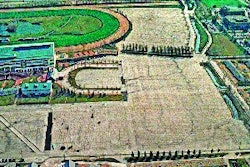From well-traveled highways to parking lots and driveways, asphalt is the “icing” on the layer cake of materials that give the roadway strength and stability. Asphalt holds aggregate materials together, helping minimize the loss of strength that could result from movement of pieces of stone and gravel in the aggregate layers. Asphalt also prevents water from infiltrating pavement sub-layers, helping to minimize swelling of clay layers and particles contained in pavement bases. Along with its flexibility and ability to protect and glue aggregate sub-layers, asphalt is vulnerable to degradation from salts, gasoline and other petroleum-based fluids and environmental effects such as freeze-thaw heaving and oxidation. As asphalt deteriorates, its color fades from a black to gray. On well-traveled roadways, deterioration is much slower than on more lightly traveled surfaces because rolling traffic has a “kneading” effect, which brings asphalt with less exposure from beneath the surface layer to the top while deteriorated material is mixed down into subsurface asphalt.
Over time – more quickly on less traveled pavements –asphalt loses its ability to bind underlying aggregate layers. The first sign of pavement deterioration is the appearance of minor surface cracks, which increase in number and size over time. If not repaired, the cracks allow water, salts and other chemicals to infiltrate the aggregate base layers. Once saturated with water, the aggregate layers swell, expanding the cracks even further. The result is larger cracks, pot holes and, in colder climates, frost heaves.
The life of asphalt on well-traveled roadways can be extended by sealing cracks as they develop. Eventually, the asphalt will either be capped or the top layers of asphalt and aggregate will be replaced.
Asphalt pavements that do not have as much rolling traffic – parking lots, airport aprons, gas stations, driveways, etc. – must be maintained differently. Without steady rolling traffic, the “kneading” effect does not occur and the top layer of asphalt continues to degrade without the benefit of being mixed with less degraded material from below the surface. Sealcoating is an essential component of a protective maintenance program for more lightly traveled pavements.
Surface layers of asphalt parking lots and other off-road pavements are under continuous attach from oil and gasoline leaks or spills, from de-icing salts and from water and the ultraviolet radiation of the sun. Sealcoats are a protective coating that resists attacks by the elements and chemicals that deteriorate asphalt.
Two types of sealcoating materials dominate the market: refined tar-based sealcoat (RTS) and asphalt-based sealcoat (ABS). RTS is made from a refined fraction of coal tar whereas ABS is made from the same refined petroleum fraction as the asphalt itself. The non-petroleum-based RTS is resistant to petroleum-based products (such as oil, grease and gasoline) and other chemicals, providing a more effective barrier that protects asphalt pavement from both the weather and substances that find their way on to paved surfaces. RTS is manufactured to a standard, so its performance characteristics are predictable. In recent years, there have been many advances in ABS formulations. ABS has many of the same properties as RTS, but it is still not usually as resistant to effects of weathering (that is, it fades more quickly) or to salts and petroleum products.
By protecting asphalt, sealcoating extends the life of the pavement thereby resulting in real savings for property owners. Unsealed asphalt pavements will require repair, sometimes as early as the second year, and could require an overlay as often as every seven years. For a 10,000 square-yard paved surface, it is estimated that, using current average costs of asphalt and sealant, sealcoating could result in a 65% cost savings over 15 years.




















